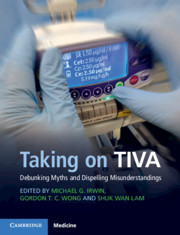Book contents
- Taking on TIVA
- Taking on TIVA
- Copyright page
- Contents
- Contributors
- Foreword
- Power to the People: the Rationale of a Practical Text
- Chapter 1 Why Bother?
- Chapter 2 You Say ‘PK’ and I Say ‘No Way!’; You Say ‘Keo’ and I Say ‘Time to Go!’
- Chapter 3 TCI and TIVA: What a Good Idea!
- Chapter 4 Milk of Amnesia
- Chapter 5 A Catwalk with a Difference
- Chapter 6 Let’s Get Started
- Chapter 7 Let’s Get Pumped!
- Chapter 8 ‘But I’m Used to MAC!’
- Chapter 9 Be Aware, Unaware and Confusion Everywhere
- Chapter 10 Do You Want Fries with That?
- Chapter 11 Intra- and Post-operative Analgesia for TIVA
- Chapter 12 Wakey Wakey!
- Chapter 13 Under Pressure
- Chapter 14 Ankle Biters
- Chapter 15 Old Timers
- Chapter 16 Big Can Be Beautiful!
- Chapter 17 A Bun in the Oven
- Chapter 18 Saving the Whales by Taking on TIVA
- Chapter 19 TIVA Drugs for Sedation
- Chapter 20 Skiing Off-Piste and Other Assorted Goodies
- Index
- References
Chapter 8 - ‘But I’m Used to MAC!’
How Do I Get the Dose Right with TIVA?
Published online by Cambridge University Press: 18 November 2019
- Taking on TIVA
- Taking on TIVA
- Copyright page
- Contents
- Contributors
- Foreword
- Power to the People: the Rationale of a Practical Text
- Chapter 1 Why Bother?
- Chapter 2 You Say ‘PK’ and I Say ‘No Way!’; You Say ‘Keo’ and I Say ‘Time to Go!’
- Chapter 3 TCI and TIVA: What a Good Idea!
- Chapter 4 Milk of Amnesia
- Chapter 5 A Catwalk with a Difference
- Chapter 6 Let’s Get Started
- Chapter 7 Let’s Get Pumped!
- Chapter 8 ‘But I’m Used to MAC!’
- Chapter 9 Be Aware, Unaware and Confusion Everywhere
- Chapter 10 Do You Want Fries with That?
- Chapter 11 Intra- and Post-operative Analgesia for TIVA
- Chapter 12 Wakey Wakey!
- Chapter 13 Under Pressure
- Chapter 14 Ankle Biters
- Chapter 15 Old Timers
- Chapter 16 Big Can Be Beautiful!
- Chapter 17 A Bun in the Oven
- Chapter 18 Saving the Whales by Taking on TIVA
- Chapter 19 TIVA Drugs for Sedation
- Chapter 20 Skiing Off-Piste and Other Assorted Goodies
- Index
- References
Summary
The recent NAP 5 report in the UK showed that many of the cases of awareness associated with TIVA were due to poor technique and inadequate dosing.[1] In short, we don’t teach TIVA as well as we do inhalational anaesthesia. Yes, we have those occasional lectures and workshops built into our curriculum for trainees, covering pharmacokinetics/pharmacodynamics (PK/PD) and TIVA. However, trainees learn from watching their seniors from day to day in the operating room (OR). The vast majority of this training is gas based; it’s easy to use, everything is set up, the vaporiser is full and you’re ready to go as soon as you reach the OR. Why bother going to all the work of setting up for TIVA: surely that’s just for specialised cases? Thus our trainees are rarely exposed to TIVA and, in turn, become the gaseous trainers of the future. No wonder that when called upon to use TIVA in those circumstances where there is no alternative, even experienced anaesthetists can have difficulty. It’s often our trainees who are called upon to provide sedation for patients transferring between locations, or provide anaesthesia and sedation in remote sites without the infrastructure to support inhalational anaesthesia. These same trainees have often not learned TIVA in a practical way and are then struggling to remember, was it mg.kg−1.h−1, or µg.kg−1.min−1? How can we transfer the knowledge and skills that we have learned, over many years of passing the gas, to the art of TIVA?
- Type
- Chapter
- Information
- Taking on TIVADebunking Myths and Dispelling Misunderstandings, pp. 52 - 62Publisher: Cambridge University PressPrint publication year: 2019

